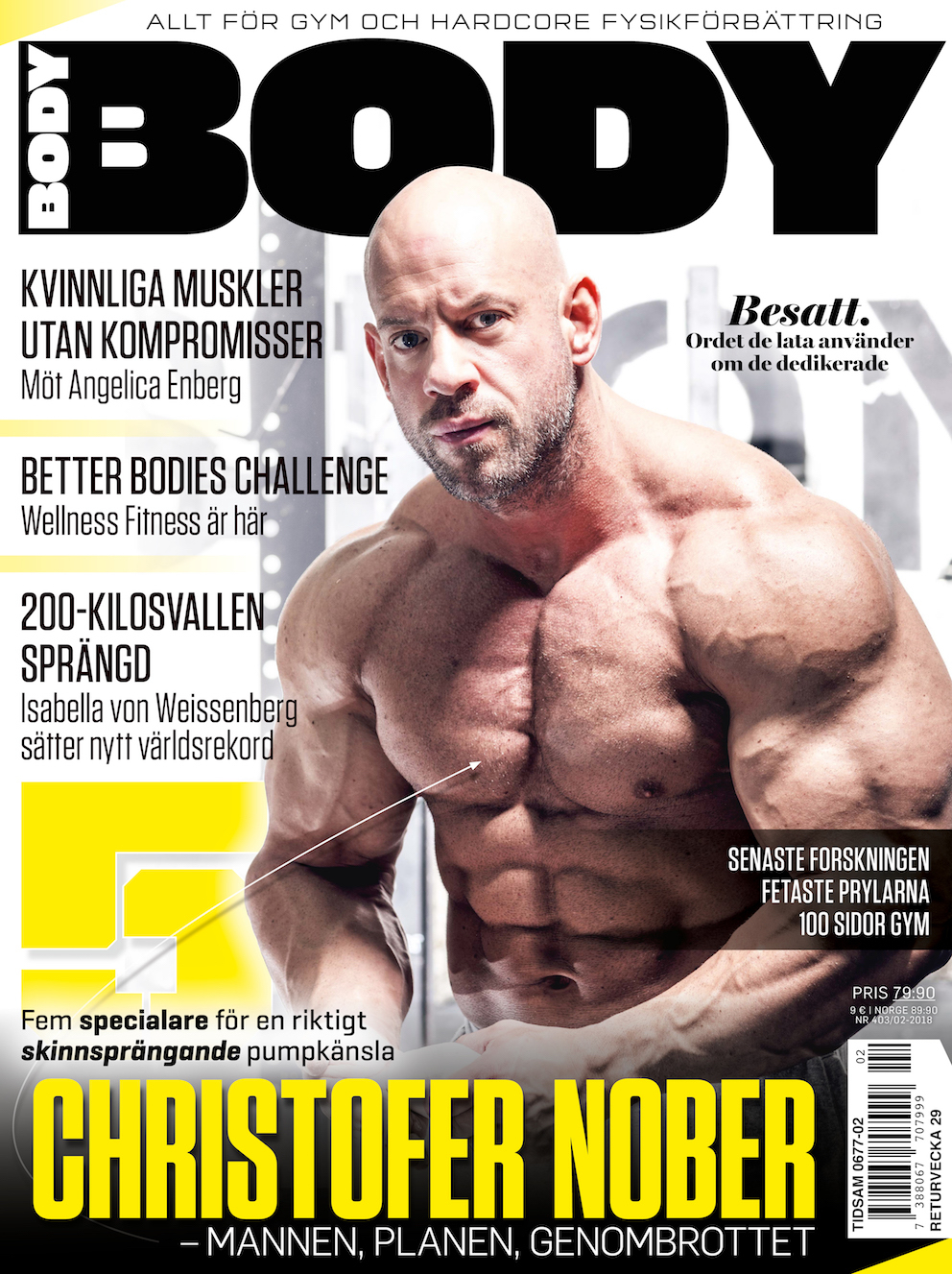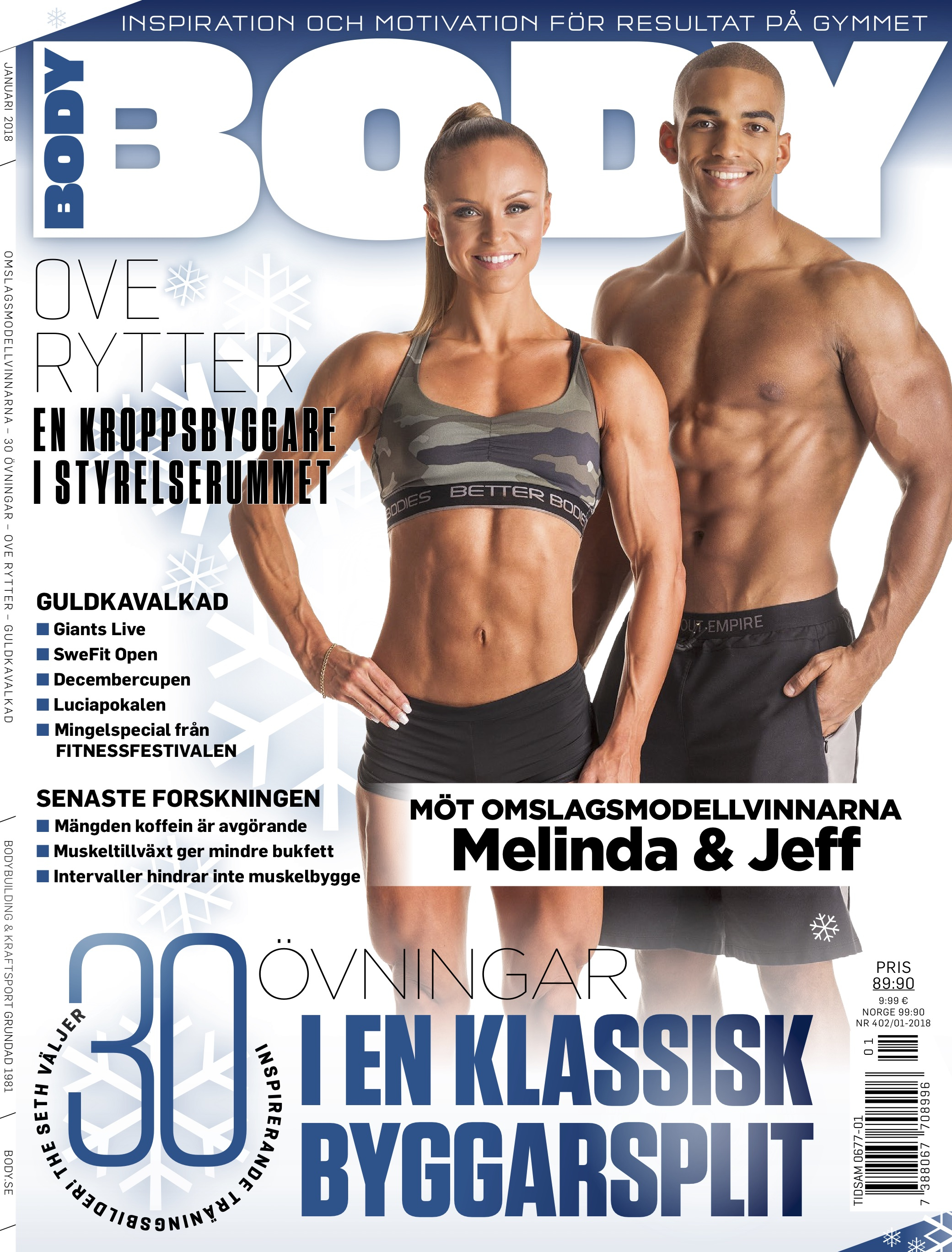Home › Forums › Kosttillskott › Kliniska Studier på tillskott
- This topic is empty.
-
AuthorPosts
-
20 februari, 2009 at 21:25 #376959
Anonym anvandare
Member[http://www.ast-ss.se/html/article.asp?ArticleID=873]
Finns det några vettiga ord här?
21 februari, 2009 at 09:24 #376960Anonym anvandare
MemberPatArnold wrote:I denna studie bevisade forskarna att 4-hydroxyisoleucine tillsammans med kolisar efter träningen var 63 % bättre på att bygga upp glukos återinlagringen jämfört med endast kolisar.
Slutsats du får 63% bättre upptag av kolisar i musklerna än endast med kolhydrater efter träning.
Ska tas med i beräkning att individerna i studierna körde en träning som tömmer mer kolhydrater än vad styrketräning i sig gör.
Mvh PATThe addition of fenugreek extract (Trigonella foenum-graecum) to glucose feeding increases muscle glycogen resynthesis after exercise.
Ruby BC, Gaskill SE, Slivka D, Harger SG.Department of Health and Human Performance, The University of Montana, Missoula, Montana 59812-1825, USA. [mailto:brent.ruby@mso.umt.edu]
The purpose of this study was to determine the effects of ingesting an oral supplement containing 4-Hydroxyisoleucine (4-OH-Ile, isolated from fenugreek seeds [Trigonella foenum-graecum]) with a glucose beverage on rates of post-exercise muscle glycogen resynthesis in trained male cyclists. Following an overnight fast (12 hr), subjects completed a 90-minute glycogen depletion ride after which a muscle biopsy was obtained from the vastus lateralis. Immediately and 2 hours after the muscle biopsy, subjects ingested either an oral dose of dextrose (Glu) (1.8 g.kg BW(-1)) or 4-OH-Ile supplement (Glu+4-OH-Ile, including 2.0 mg.kg(-1) 4-OH-Ile with the same oral dose of dextrose) with a second muscle biopsy 4 hours after exercise. Post exercise muscle glycogen concentration was similar for both trials. Overall, there was a significant increase in glucose and insulin concentrations from time 0 throughout the majority of the 4-hour recovery period, with no significant differences between the two trials at any time point. Although muscle glycogen concentration significantly increased from immediately post exercise to 4 hr of recovery for both trials, the net rate of muscle glycogen resynthesis was 63% greater during Glu+4-OH-Ile (10.6+/-3.3 vs. 6.5+/-2.6 g.kg wet wt.(-1).hr.(-1) for the Glu+4-OH-Ile and Glu trials, respectively). These data demonstrate that when the fenugreek extract supplement (4-OH-Ile) is added to a high oral dose of dextrose, rates of post-exercise glycogen resynthesis are enhanced above dextrose alone.
perfekt. Det har visats att koffein efter träning i samband med kolhydrater gav 66% effektivare glykogeninlagring med.
Så tar man fenugreek och koffein tillsammans med vitargo borde man få 129% bättre glykogeninlagring i musklerna?!10 mars, 2009 at 09:46 #376961Anonym anvandare
Membercreatine ethyl ester = verkningslöst
The effects of creatine ethyl ester supplementation combined with heavy resistance training on body composition, muscle performance, and serum and muscle creatine levels.
ABSTRACT: Numerous creatine formulations have been developed primarily to maximize creatine absorption. Creatine ethyl ester is alleged to increase creatine bio-availability. This study examined how a seven-week supplementation regimen combined with resistance training affected body composition, muscle mass, muscle strength and power, serum and muscle creatine levels, and serum creatinine levels in 30 non-resistance-trained males. In a double-blind manner, participants were randomly assigned to a maltodextrose placebo (PLA), creatine monohydrate (CRT), or creatine ethyl ester (CEE) group. The supplements were orally ingested at a dose of 0.30 g/kg fat-free body mass (approximately 20 g/day) for five days followed by ingestion at 0.075 g/kg fat free mass (approximately 5 g/day) for 42 days. Results showed significantly higher serum creatine concentrations in PLA (p = 0.007) and CRT (p = 0.005) compared to CEE. Serum creatinine was greater in CEE compared to the PLA (p = 0.001) and CRT (p = 0.001) and increased at days 6, 27, and 48. Total muscle creatine content was significantly higher in CRT (p = 0.026) and CEE (p = 0.041) compared to PLA, with no differences between CRT and CEE. Significant changes over time were observed for body composition, body water, muscle strength and power variables, but no significant differences were observed between groups. In conclusion, when compared to creatine monohydrate, creatine ethyl ester was not as effective at increasing serum and muscle creatine levels or in improving body composition, muscle mass, strength, and power. Therefore, the improvements in these variables can most likely be attributed to the training protocol itself, rather than the supplementation regimen.12 juli, 2009 at 15:09 #376962Anonym anvandare
MemberTestosterone:estradiol ratio changes associated with long-term tadalafil administration: a pilot study.
INTRODUCTION: It has been reported that lack of sexual activity due to erectile dysfunction (ED) may be associated with testosterone (T) decline. AIM: To investigate whether the known changes in sex hormones associated with resumption of sexual activity are sustained in the long term. MAIN OUTCOME MEASURES: Primary endpoints were variations from baseline of steroid hormones: total T, free T (f T), and estradiol (E). Secondary endpoints were variations of erectile function domain scores at International Index of Erectile Function-5 (IIEF-5). METHODS: In an open-label fashion, 20 patients (mean age 54.8 +/- 8.4 years) received tadalafil 10-20 mg on demand for 12 months. Exclusion criteria were those reported for phosphodiesterase inhibitors, including hypogonadism and hyperprolactinemia. RESULTS: Tadalafil assumption was safe and well tolerated (overall adverse effects in 15% of patients) and none discontinued medication. A significant decrease in E levels occurred at the end of the study (from 19.9 +/- 9.6 to 16.6 +/- 8.1 ng/dL, P = 0.042 vs. baseline), with parallel increase in the T:E ratio (26.3 +/- 15.3 to 32.6 +/- 17.7, P = 0.05), whereas no changes in T and f T serum levels were observed, respectively (411.4 +/- 131.4 to 434.2 +/- 177.1 ng/dL and 47.7 +/- 15.3 to 49.9 +/- 19.1 pmol/L, not significant). Interestingly, nonparametric subgroup analysis for related samples revealed that E decrease was detectable only in lean (N = 14) but not in obese (N = 6, body mass index > 27.5 kg/m2) subjects (17.8 +/- 10.1 vs. 13.5 +/- 6.8, P < 0.05). A net increase in IIEF-5 scores was observed at the endpoint (13.7 +/- 5.9 vs. 25.7 +/- 2.9, P < 0.0001). CONCLUSIONS: Sustained improvement in sexual function after 12 months of tadalafil administration is associated with increased T:E ratio mainly related to reduction of E levels. We hypothesize that androgen-estrogen cross-talk and possible inhibition of aromatase activity during chronic exposure to tadalafil might have a role in the regulation of erectile function.
källa: [http://www.ncbi.nlm.nih.gov/pubmed/16839328]
Så Viagra är Anti östrogent :up:
13 juli, 2009 at 09:11 #376963Anonym anvandare
MemberDet är ju ett receptbelagt läkemedel och inte ett kosttillskott.
13 juli, 2009 at 10:51 #376964Anonym anvandare
MemberBiotin deficiency in mice is associated with decreased serum availability of insulin-like growth factor-I.
BACKGROUND: Biotin deficiency leads to decreased weight and nose-rump length in mice. AIM OF THE STUDY: The mechanisms underlying this impairment in body growth are yet unclear. Biotin restriction, however, could affect the availability of growth hormone (GH) and/or insulin like growth factor-I (IGF-I) since both hormones control body growth. We then conducted a correlative study aimed at establishing whether biotin dietary restriction is associated with decreased GH/IGF-I serum concentrations. METHODS: Levels of GH and IGF-I were measured through ELISA in serum samples of male BALB/cAnN mice fed with: 1] standard chow diet (control diet); 2] 30% egg-white biotin-deficient diet; or 3] 30% egg-white diet supplemented with 16.4 micromol biotin per kilogram (biotin sufficient diet). Relative food consumption, as adjusted per gram of body weight, was also determined. GH and IGF-I measurements were taken individually for 20 weeks beginning at the postnatal week 3, when the animals started consuming the corresponding diets. In addition, femur’s weight and longitudinal growth and the organization of its growth plate were all analyzed as indicators of GH/IGF-I function. RESULTS: No differences in relative food consumption were observed among the three groups of mice along the experimental period that was evaluated. IGF-I serum levels, but not GH ones, were decreased in biotin deficient mice. These animals also showed decreased femur’s longitudinal growth, speed of lengthening and weight gain, as well as shorter and disorganized growth plates. CONCLUSIONS: This study shows that biotin dietary restriction is indeed associated with decreased availability of IGF-I and diminished long bone growth and elongation. These conditions could explain the impairment of longitudinal body growth previously reported in biotin deficient mice. Although cause-effect studies are still needed, we believe our results support the notion that biotin might modulate the availability of IGF-I.
källa: [http://www.ncbi.nlm.nih.gov/pubmed/19165522]
13 juli, 2009 at 10:53 #376965Anonym anvandare
MemberOla Wallengren wrote:Det är ju ett receptbelagt läkemedel och inte ett kosttillskott.förvisso, men intressant ur forskningsynpunkt. Kanske nått att ha med i kommande Body…
 14 juli, 2009 at 20:10 #376966
14 juli, 2009 at 20:10 #376966Anonym anvandare
MemberIntar man vassle regelbundet ökar ens insulin nivåer, medans kasein inte påverkar hormonet. Dock ökar kasein ens IGF-1 nivåer avsevärt, närmare 15%.
Läs mer:Differential effects of casein versus whey on fasting plasma levels of insulin, IGF-1 and IGF-1/IGFBP-3: results from a randomized 7-day supplementation study in prepubertal boys
Background/Objectives:
Milk increases both fasting insulin and insulin-like growth factor 1 (IGF-1), and thereby growth, in healthy prepubertal boys. It is, however, unknown which components in milk are responsible for milk’s growth-stimulating effect.Subjects/Methods:
To get closer to the identification of which components in milk that stimulate growth, we have performed an intervention study with 57 eight-year-old boys in which we examined the effects of the two major milk protein fractions, whey and casein, and milk minerals (Ca and P) in a 2 times 2 factorial design on IGFs and glucose-insulin metabolism. The amounts of whey and casein were identical to the content in 1.5 l skim milk. The amounts of Ca and P were similar to 1.5 l skim milk in the high-mineral drinks, whereas the amounts of Ca and P were reduced in the low-mineral drinks.Results:
There were no interactions between milk mineral groups (high, low) and milk protein groups (whey, casein). Serum IGF-1 increased by 15% (P15 juli, 2009 at 00:10 #376967Anonym anvandare
Memberloverius wrote:Intar man vassle regelbundet ökar ens insulin nivåer, medans kasein inte påverkar hormonet. Dock ökar kasein ens IGF-1 nivåer avsevärt, närmare 15%.
Läs mer:Differential effects of casein versus whey on fasting plasma levels of insulin, IGF-1 and IGF-1/IGFBP-3: results from a randomized 7-day supplementation study in prepubertal boys
Background/Objectives:
Milk increases both fasting insulin and insulin-like growth factor 1 (IGF-1), and thereby growth, in healthy prepubertal boys. It is, however, unknown which components in milk are responsible for milk’s growth-stimulating effect.Subjects/Methods:
To get closer to the identification of which components in milk that stimulate growth, we have performed an intervention study with 57 eight-year-old boys in which we examined the effects of the two major milk protein fractions, whey and casein, and milk minerals (Ca and P) in a 2 times 2 factorial design on IGFs and glucose–insulin metabolism. The amounts of whey and casein were identical to the content in 1.5 l skim milk. The amounts of Ca and P were similar to 1.5 l skim milk in the high-mineral drinks, whereas the amounts of Ca and P were reduced in the low-mineral drinks.Results:
There were no interactions between milk mineral groups (high, low) and milk protein groups (whey, casein). Serum IGF-1 increased by 15% (P20 juli, 2009 at 19:15 #376968Anonym anvandare
MemberEffects of nine weeks of beta-hydroxy-beta- methylbutyrate supplementation on strength and body composition in resistance trained men.
Thomson JS, Watson PE, Rowlands DS.
The Institute of Food, Nutrition & Human Health, Massey University, Albany, New Zealand. [mailto:J.A.Thomson@massey.ac.nz][/b]The dietary supplement beta-hydroxy-beta-methylbutyrate (HMB) is claimed to increase strength, lean body mass, and decrease fat mass when used in conjunction with resistance training. Although there is some support for these claims, the evidence is not conclusive, and it is even less so for resistance trained individuals. Therefore, we aimed to further elucidate the effects of HMB supplementation in trained men. A randomized, double-blind, controlled study design was used to investigate the effects of supplementing 22 resistance trained men with 3 g.d of HMB or corn starch placebo for 9 weeks with resistance training. The effect of HMB on strength was determined using the 1-repetition maximum (1RM) method for the lower body (leg extension) and upper body (bench press, bicep preacher curl) at baseline and after the supplementation period. Body composition was assessed by skinfolds and bioelectrical impedance analysis (BIA). Overall, 9 weeks’ HMB supplementation resulted in a clear-cut, trivial increase in combined averaged strength measures of 1.6% (90% confidence limits: +/-4.3%). When considered in isolation, however, leg extension 1RM increased by a substantial 9.1% (90% confidence limits: +/-7.5%), but the effect on upper-body strength was inconclusive (bench press: -1.9 +/- 9.3%; bicep curl: -1.7 +/- 4.7%). Based on BIA estimates, HMB had a decreasing (although inconclusive) influence on fat mass of -9 +/- 14%, but it had a clear, trivial effect on fat-free mass of 0.2 +/- 2.2%. The magnitude of change in body mass was trivial, but the probability of substantial reductions in skinfold thicknesses ranged from negligible to likely. In previously trained men, supplementation of HMB in conjunction with resistance training provides a substantial benefit to lower-body strength, but it has negligible effects on body composition.
PMID: 19387396 [PubMed – in process][/b]23 juli, 2009 at 19:28 #376969Anonym anvandare
MemberAcute effects of a thermogenic nutritional supplement on cycling time to exhaustion and muscular strength in college-aged men
Background
The purpose of the present study was to examine the acute effects of a thermogenic nutritional supplement containing caffeine, capsaicin, bioperine, and niacin on muscular strength and endurance performance.Methods
Twenty recreationally-active men (mean ± SD age = 21.5 ± 1.4 years; stature = 178.2 ± 6.3 cm; mass = 76.5 ± 9.9 kg; VO2 PEAK = 3.05 ± 0.59 L/min-1) volunteered to participate in this randomized, double-blinded, placebo-controlled, cross-over study. All testing took place over a three-week period, with each of the 3 laboratory visits separated by 7 days (± 2 hours). During the initial visit, a graded exercise test was performed on a Lode Corival cycle ergometer (Lode, Groningen, Netherlands) until exhaustion (increase of 25 W every 2 min) to determine the maximum power output (W) at the VO2 PEAK (Parvo Medics TrueOne® 2400 Metabolic Measurement System, Sandy, Utah). In addition, one-repetition maximum (1-RM) strength was assessed using the bench press (BP) and leg press (LP) exercises. During visits 2 and 3, the subjects were asked to consume a capsule containing either the active supplement (200 mg caffeine, 33.34 mg capsaicin, 5 mg bioperine, and 20 mg niacin) or the placebo (175 mg of calcium carbonate, 160 mg of microcrystalline cellulose, 5 mg of stearic acid, and 5 mg of magnesium stearate in an identical capsule) 30 min prior to the testing. Testing included a time-to-exhaustion (TTE) ride on a cycle ergometer at 80% of the previously-determined power output at VO2 PEAK followed by 1-RM LP and BP tests.Results
There were no differences (p > 0.05) between the active and placebo trials for BP, LP, or TTE. However, for the BP and LP scores, the baseline values (visit 1) were less than the values recorded during visits 2 and 3 (p ≤ 0.05).Conclusion
Our findings indicated that the active supplement containing caffeine, capsaicin, bioperine, and niacin did not alter muscular strength or cycling endurance when compared to a placebo trial. The lack of increases in BP and LP strength and cycle ergometry endurance elicited by this supplement may have been related to the relatively small dose of caffeine, the high intensity of exercise, the untrained status of the participants, and/or the potential for caffeine and capsaicin to increase carbohydrate oxidation.[http://www.jissn.com/content/6/1/15]
15 oktober, 2009 at 23:43 #376970Anonym anvandare
MemberEffects of 28 days of resistance exercise and consuming a commercially available pre-workout supplement, NO-Shotgun®, on body composition, muscle strength and mass, markers of satellite cell activation, and clinical safety markers in males[/b]
Purpose
This study determined the effects of 28 days of heavy resistance exercise combined with the nutritional supplement, NO-Shotgun®, on body composition, muscle strength and mass, markers of satellite cell activation, and clinical safety markers.Methods
Eighteen non-resistance-trained males participated in a resistance training program (3 × 10-RM) 4 times/wk for 28 days while also ingesting 27 g/day of placebo (PL) or NO-Shotgun® (NO) 30 min prior to exercise. Data were analyzed with separate 2 × 2 ANOVA and t-tests (p < 0.05).Results
Total body mass was increased in both groups (p = 0.001), but without any significant increases in total body water (p = 0.77). No significant changes occurred with fat mass (p = 0.62); however fat-free mass did increase with training (p = 0.001), and NO was significantly greater than PL (p = 0.001). Bench press strength for NO was significantly greater than PL (p = 0.003). Myofibrillar protein increased with training (p = 0.001), with NO being significantly greater than PL (p = 0.019). Serum IGF-1 (p = 0.046) and HGF (p = 0.06) were significantly increased with training and for NO HGF was greater than PL (p = 0.002). Muscle phosphorylated c-met was increased with training for both groups (p = 0.019). Total DNA was increased in both groups (p = 0.006), while NO was significantly greater than PL (p = 0.038). For DNA/protein, PL was decreased and NO was not changed (p = 0.014). All of the myogenic regulatory factors were increased with training; however, NO was shown to be significantly greater than PL for Myo-D (p = 0.008) and MRF-4 (p = 0.022). No significant differences were located for any of the whole blood and serum clinical chemistry markers (p > 0.05).Conclusion
When combined with heavy resistance training for 28 days, NO-Shotgun® is not associated with any negative side effects, nor does it abnormally impact any of the clinical chemistry markers. Rather, NO-Shotgun® effectively increases muscle strength and mass, myofibrillar protein content, and increases the content of markers indicative of satellite cell activation.[http://www.ncbi.nlm.nih.gov/pubmed/19656392?dopt=AbstractPlus&holding=f1000,f1000m,isrctn]
18 januari, 2010 at 22:44 #376971Anonym anvandare
MemberIngen som har något mer att bidraga med här?
2 februari, 2010 at 20:51 #376972Anonym anvandare
MemberMen samtidigt…finns mkt att läsa på [www.jissn.com]
7 februari, 2010 at 18:19 #376973Anonym anvandare
MemberCurr Opin Clin Nutr Metab Care. 2010 Jan 25.
Long-term effects of leucine supplementation on body composition.
PURPOSE OF REVIEW: Leucine does not only serve as a substrate for protein synthesis but is also recognized as a potent signal nutrient that regulates protein metabolism. Accordingly, leucine supplementation has been suggested to develop muscle mass or prevent protein loss in several conditions characterized by muscle protein wasting. In the present review, we reported the recent results related to the effect of dietary leucine or leucine-rich amino acid mixture and proteins on whole body composition. RECENT FINDINGS: Although recent studies corroborate that increasing plasma leucine concentration generally induces an increase in muscle protein synthesis, long-term dietary leucine supplementation has been poorly investigated. Chronic free leucine supplementation alone did not improve lean body or muscle mass during resistance training or in elderly, whereas it was able to limit the weight loss induced by malnutrition. Contradictory data were also reported concerning the effect of leucine supplementation for weight management in obese patients. Leucine-rich amino acid mixture or proteins appeared more efficient than leucine alone to improve muscle mass and performance, suggesting the efficacy of leucine depends nevertheless on the presence of other amino acids. SUMMARY: Until now, there is no evidence that chronic leucine supplementation is efficient in promoting muscle mass or preventing protein loss during catabolic states. Further studies are required to determine the duration and nutritional conditions of long-term leucine supplementation and to establish whether such nutritional interventions can help to prevent or treat muscle loss in various pathological or physiological conditions.

-
AuthorPosts
- You must be logged in to reply to this topic.






